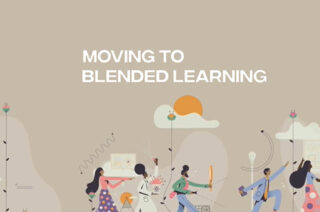Why is online different?

Blended learning is an approach to education that combines online educational materials and opportunities for interaction online with traditional place-based classroom methods. It requires the physical presence of both teacher and learner, with some elements of learner control over time, path or place (see the definitions of blended learning FSE Teaching Academy video). The same principles of good teaching apply to both the face-to-face and online elements of blended learning. However, these principles become even more important online, where the remote nature of teaching and learning can amplify problems. There is strong evidence from research that online learning is at least as effective as face-to-face, and often significantly better (Siemens et al, 2015).
“One of the common mistakes in online delivery is trying to replicate the original format. Without the visual and verbal cues that come when people are in the same physical space, it can result in a frustrating and disappointing experience.”
James Clay, head of higher education and student experience at JISC
What do learners say?
Engineering learners who had an expectation of an on-campus experience, but are now forced into online learning, are quite different from those who originally chose to follow an online course. Initial research amongst this learner population suggests a wide range of feelings about the sudden change to online learning, much of them negative (Douglas, 2020). Although some University of Manchester learners have already been reflecting on how the sudden change to online learning has provided some unexpected opportunities and skills.
Motivation and emotions
Many learners felt alone and unsupported, and hence found it hard to get motivated. Many also became lost or confused, unsure of what they should be doing. Lacking the implicit social encouragement or expectations of face-to-face interaction, it was hard for them to know how they were doing, if they were left behind or doing well. This led to stress or worry, and learners thought they were the only ones feeling like this.
Social interaction
“The only reason I passed is because of my friends”
Learners get a sense of social pressure, encouragement and expectation to work from their peers. Additionally, a substantial amount of peer learning happens on-campus. On campus, learners ask each other for guidance on what they should be working on, use their peers to set expectations around performance and workload, and explicitly teach each other. This happens a lot more than you may think and is a big part of the learning experience, but it becomes a lot harder online, especially for learners who are just joining the University and do not have established friendship groups from their course.
Feedback
Learners find that getting answers to their questions can take longer than in face-to-face sessions. If they send a question in email or in a discussion board and they don’t understand the answer, they ‘feel weird asking twice’. Learners are also less likely to study in informal groups and give informal feedback. Generally, in a class, a few learners may give feedback and ask questions, while other learners will listen and benefit from these exchanges. From an instructor perspective, you are also not getting the same feedback from learners that enables you to see what parts of the course they are not understanding or finding difficult, and what extra support learners may need.
Time Management
Learners can study where and when they want. They often like this flexibility, but there is less social pressure to study at a particular time, hence learners need better study habits and time management. Learners are required to take more responsibility for their learning. More discipline may be required to keep pace with a course. At the same time, learners are more likely to disengage from online learning faster than from face-to-face.
This flexibility also means that asynchronous learning plays a bigger role. Whilst synchronous communication happens live and in real-time (e.g. online Blackboard Collaborate sessions), asynchronous communication happens when participants contribute to the communication at different times, not live and in real-time. Examples of asynchronous communication tools include email messages, discussion boards, blogging, and text messaging. Asynchronous communication can present opportunities for self-reflection, which can be important online in promoting and monitoring learner engagement and learning. Some learners will prepare and reflect on asynchronous messages in a much more considered way than they might interact in class. And these communications will be available for learners to review at any stage of the course. Social and cultural characteristics may mean that some learners may feel more comfortable interacting in an online environment – either synchronously or asynchronously. Likewise, learners with a physical disability may be able to participate more fully in an online environment.
Technology
Learners interact online using a computer and software, which they may not know how to use effectively. In addition, learners have been studying in classrooms for many years and have much experience of classroom norms. They may not be so conversant with how to work in a productive and collaborative manner online.
In the Jisc Digital Insights survey from students, around a quarter of students (FE 29%, HE 24%) said they had never worked online with others. So, jumping straight into group activities because the most popular tools are geared for it, without proper planning or learner support, could be a less effective experience for students.
Tooling Up to Teach Online
Learners may also have issues accessing online materials and activities due to their technical setup (the devices and internet connections they have) or due to disabilities. They may be using assistive software. Fully accessible online materials are a legal requirement.
How can we address these issues?
“An online learner is usually studying in an isolated situation, without other students or the instructor physically present. There are many ways to overcome the isolation of the online learner …, but giving them recordings of 50-minute classroom presentations is not one of them.”
Tony Bates, the 10 fundamentals of teaching online for faculty and instructors (2016)
As we said at the start, the same basic principles apply as when you are creating an excellent face-to-face course. Provide clear and specific guidance, define high expectations, and make sure your learners know these. Structure your course with plenty of feedback and interaction both between learners and between you and your learners. Generally, aim to design courses to make learning visible; find a way to see if each activity has ‘worked’, i.e. are you able to see if the learner has learnt from that piece of material?
We have included some common challenges and potential solutions below. Many of these are discussed in more depth in the next section on ‘Setting Expectations and Building community’. It’s worth noting that there can be a significant upfront investment in setting up a successful online course. But the more you prepare, the better the experience will be for you and your learners.
Learners will know what to expect, how to interact and behave, what they need to do and when, and how long it should take. There will be less room for misunderstanding, you will receive fewer individual queries, and you and your learners will gain a sense of how they are progressing towards achieving the learning objectives.
“Most instructors… find a time shift when they move to online teaching. The more time you put into the development of the course… the less time you find yourself spending on content during the delivery of the course, because it is already there. “
Tony Bates, the 10 fundamentals of teaching online for faculty and instructors (2016)
- In your online classroom, use breakout groups to enable learners to work together in smaller groups. Visit each group in turn.
- Set discussion forum activities.
- Schedule virtual co-working sessions, when learners can login and work together and get peer support.
| Problem / Issue / Challenge | Solution & Examples |
| Learners often get ‘lost’ when studying | Give clear guidance on what you expect a learner to do.
|
| Learners feel isolated and lack peer support | Design tasks to get learners talking to each other – this is especially important in the early weeks. |
| Encourage use of backchannels during online classrooms
| |
| Enable online peer interactions | |
| Encourage learners to set up and manage their own informal support groups online. |
Learner problems are sent by email
| Share learner course content queries across the cohort.
|
| Enable learners to ask questions in real-time and discuss the answer.
|
Learners don’t have a sense of how they are performing on the course unit
| Give regular whole group and personal feedback
|
| Make it clear when you are giving feedback and how it should be used. |
| Provide means for learners to talk to each other about progress
|
| Give a lot of encouragement. |
| Consider using peer marking. |
As an instructor you don’t get the same feedback from learners
| Ask for feedback via other methods.
|
Online interactions are less personal that face-to-face interactions when you are teaching (e.g. immediate, visual)
| Talk to learners in a friendly, conversational and encouraging way – think ‘chat with a friend’ not ‘talking to a room of strangers’. |
| Initially, spend time getting to know the learners online and finding out how they feel about online learning
|
Learners need equipment and software. They also need to be able to use the tools and processes involved in online learning
| We can help by agreeing as a department a common set of educational tools we will use and showing learners how to use them. Resources and guidance for learners should be provided when using unfamiliar online learning tools or processes. |
| Learners and instructors require full access to all of the tools that will be used for learning, both in terms of equipment and software. Online privacy issues should be addressed, with some tools, for example, requiring accounts to be set up. |
| All tools used should be fully accessible to the diverse range of learners who will be asked to use them.
|
| Include ‘easy’ orientation activities that accustom the learners to the tools and processes that will be used in the course unit. |
Learners don’t know how to conduct themselves in an online course
| Set expectations.
|
This is a relatively short and practical list. For more detail, including references to evidence and examples in the literature, see Summary of Instructional Activities for Communities of Inquiry (CoI), table 1
Further Resources
Synchronous and asynchronous learning: A description of the two basic formats of learning in an online environent and when to use.


